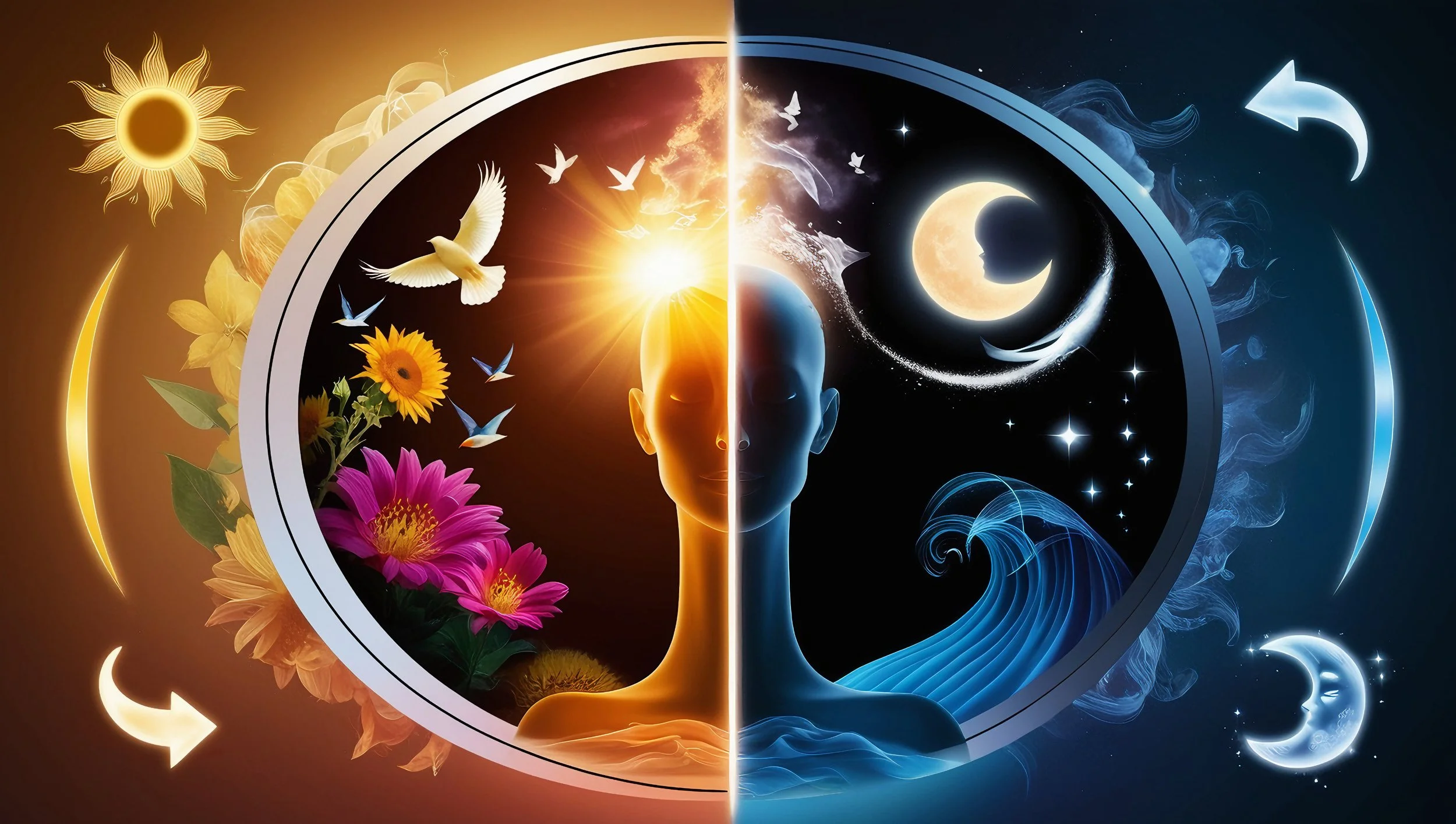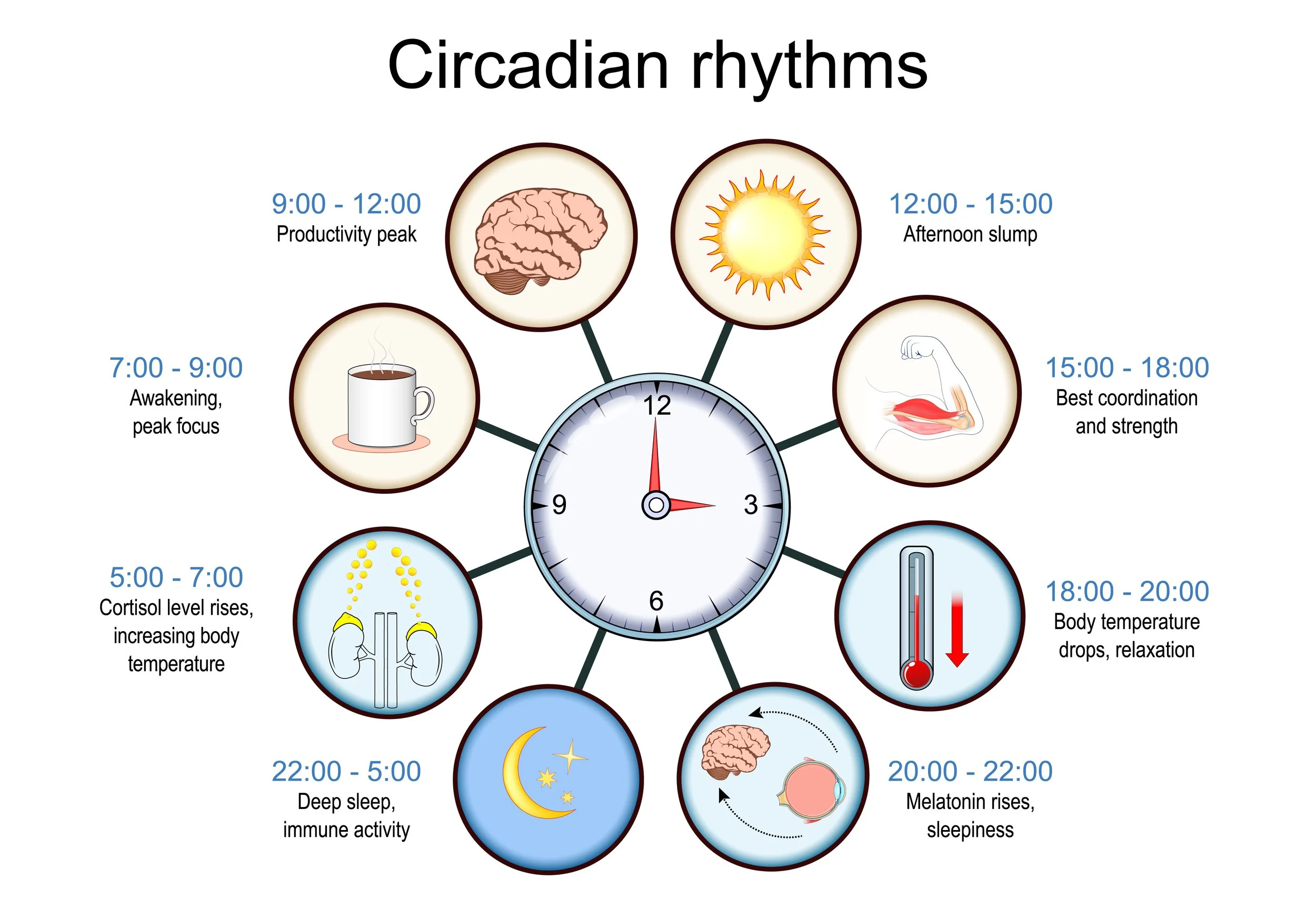Cortisol Rhythm Reset: How to Boost Energy, Reduce Stress and Sleep Better
Many women I work with tell me they think cortisol is simply a “stress hormone” that causes weight gain, anxiety, and sleep problems. The truth is a little more nuanced. Cortisol isn’t bad at all. In fact, it’s essential for your health. The real problem comes when your cortisol rhythm is out of balance.
When this happens, you may feel tired in the morning, wired at night, constantly stressed, and unable to sleep. Sound familiar? For women over 40, especially in perimenopause and menopause, this disrupted rhythm can worsen symptoms like brain fog, mood swings, and stubborn weight gain. The good news? By learning how to reset your cortisol rhythm, you can restore your energy, calm your stress, and finally get a good night’s rest.
What is Cortisol and Why Does It Matter?
Cortisol is often labelled as “the stress hormone”, but that’s only part of the story. Yes, your body releases cortisol in response to stress, but its role is far bigger than that. Cortisol is produced by your adrenal glands and is essential for survival. It helps regulate your metabolism, supports your immune system, controls blood sugar levels, and gives you the energy and focus to get through the day. Without cortisol, you wouldn’t be able to wake up in the morning, respond to challenges, or recover from illness.
Cortisol follows a natural 24-hour rhythm, known as the diurnal or circadian rhythm. Levels peak in the morning — this is what helps you feel alert and ready for the day. They then gradually decline throughout the day, reaching their lowest point at night to allow for rest and deep sleep. Think of it as your body’s built-in energy and recovery cycle.
The problem comes when this rhythm is disrupted. Chronic stress, late nights, caffeine overload, poor diet, lack of daylight, and hormonal changes (such as those in perimenopause and menopause) can all flip the pattern upside down. Instead of feeling energised in the morning, you wake up groggy with low cortisol. And instead of winding down at night, cortisol stays high, leaving you restless, anxious, or wide awake at 2 am.
That’s why understanding your daily cortisol rhythm is so important. It isn’t about having too much or too little cortisol overall, it’s about whether it’s showing up at the right times of day. When you get the rhythm right, you feel energised, calm, focused, and ready for restorative sleep. When it’s out of sync, everything feels harder, from managing your weight to controlling your mood.
Morning Reset: How to Boost Cortisol Naturally
Your morning sets the tone for your whole day. Cortisol should be at its highest first thing, giving you energy, focus, and motivation. If your cortisol is too low in the morning, you’ll feel sluggish and struggle to get going. Supporting your natural cortisol rhythm early helps to stabilise energy levels and prevent that mid-afternoon crash. Here’s how to start your day right:
Get outside within 30 minutes of waking
Morning light is the most powerful signal to your body clock (circadian rhythm) that it’s time to be awake and alert. Exposure to natural sunlight triggers a healthy cortisol rise, boosting energy and mood. In winter or darker climates, a 10,000 lux light therapy lamp can be a great alternative. This simple step can also improve sleep later by reinforcing the natural day–night rhythm.Drink water before caffeine
Reaching straight for coffee may feel tempting, but it can cause a sharp cortisol spike, which then drops quickly and leaves you feeling jittery or anxious. Hydrating first thing supports energy without overstimulating the adrenal system. Waiting 60–90 minutes before having coffee means you ride your body’s natural cortisol wave, keeping energy steadier throughout the morning.Move your body
Gentle morning exercise such as a short walk, yoga, or stretching helps regulate cortisol, improves circulation, and clears mental fog. Strength training can also give an extra cortisol boost when you need more alertness. Even ten minutes of light movement can help you feel more awake and focused.Eat a protein-rich breakfast
Starting the day with protein (such as eggs, Greek yoghurt, or a protein smoothie) helps stabilise blood sugar, which in turn keeps cortisol balanced. When breakfast is mostly carbohydrate or sugar, it can cause a spike and crash, leading to cravings and low energy later. A protein-rich start helps your body maintain calm, steady energy and reduces stress on the adrenal system.
Supporting your morning cortisol rise isn’t just about energy for today, it also sets your body up for better sleep at night. A well-regulated morning rhythm creates a strong contrast with the natural evening dip in cortisol, which is what helps you feel calm and ready for rest.
Afternoon Balance: Steady Energy Without the Slump
By mid-afternoon, your cortisol should be gently declining — enough to help you wind down later but not so much that you feel like you need a nap at your desk. Unfortunately, this is the time of day when many women reach for coffee, biscuits, or a sugary snack, which can make things worse in the long run. Supporting your cortisol rhythm in the afternoon is about balance, not quick fixes.
Avoid constant caffeine top-ups
While an extra cup of coffee might give you a short-term lift, it can also keep cortisol artificially high, making it harder to relax and sleep later. Caffeine in the afternoon can delay your natural cortisol dip and leave you feeling wired at night. If you do fancy a warm drink, herbal teas such as rooibos, peppermint, or chamomile are gentler alternatives.Take a short walk outdoors
A quick 10–15 minute walk in daylight is one of the most effective ways to keep your energy steady. Afternoon light reinforces your body clock, helps maintain a healthy cortisol rhythm, and can boost mood, especially during darker months. Even a walk around the block or standing outside for fresh air can reset your energy far better than a sugary snack.Eat balanced meals and snacks
Blood sugar dips can mimic stress in the body, triggering cortisol release and making you feel tired, shaky, or irritable. To avoid this, focus on balanced meals that pair protein (chicken, fish, beans, or nuts) with healthy fats and fibre-rich foods like vegetables, fruit, or wholegrains. If you need a snack, choose something nourishing like apple slices with nut butter, Greek yoghurt with berries, or a handful of nuts and seeds. These options give your body sustained fuel without overstimulating cortisol.
Supporting your cortisol rhythm in the afternoon is about preventing big spikes and crashes. When you keep things steady, you’ll find you can concentrate better, avoid that dreaded “3 pm slump”, and arrive at the evening feeling calmer, rather than drained or stressed.
Evening Wind-Down: Lowering Cortisol for Better Sleep
By the evening, your cortisol should naturally be at its lowest. This gentle decline is what prepares your body and mind for deep, restorative sleep. But for many women, especially during perimenopause and menopause, evening cortisol can stay too high. That’s when you feel “tired but wired” — exhausted yet unable to switch off. Supporting a healthy cortisol rhythm in the evening is about creating the right signals to help your body relax and reset.
Dim the lights
Bright lights trick your brain into thinking it’s still daytime, which keeps cortisol elevated. By dimming the lights in the evening or swapping to warmer amber or red-toned bulbs, you signal to your body that it’s time to slow down. Soft lighting encourages melatonin release, the hormone that helps you sleep. Even simple touches like lighting candles at dinner can support a calmer evening rhythm.Limit screens
Phones, tablets, and laptops give off blue light, which stimulates cortisol and suppresses melatonin. If you must use devices in the evening, apply blue-light filters or use glasses designed to block blue wavelengths. Better still, set a digital cut-off an hour before bed and replace scrolling with something soothing, reading, listening to calming music, or gentle stretching.Choose a light dinner with starchy carbs
A heavy, late-night meal can overstimulate your digestive system and affect sleep quality. Instead, opt for a lighter dinner that includes some complex, starchy carbohydrates like sweet potato, quinoa, or brown rice. These foods gently raise serotonin levels, which in turn helps the body produce melatonin. For many women, this combination makes it easier to fall asleep and stay asleep through the night.Practise relaxation techniques
Stress management is key to lowering evening cortisol. Practices such as Yoga Nidra, journaling, or slow breathing exercises calm the nervous system and reduce the stress signals that keep cortisol high. Even 5–10 minutes of deep breathing, with a longer exhale than inhale, can shift the body into a state of rest and relaxation. Experiment with different techniques to find what feels most enjoyable and sustainable for you.Be mindful of evening workouts
Exercise is a powerful way to regulate cortisol but timing matters. Intense exercise such as HIIT or heavy strength training too close to bedtime can raise evening cortisol and make it harder to fall asleep. If evenings are the only time you can work out, opt for gentler forms of movement like yoga, Pilates, or a walk. These activities support your cortisol rhythm rather than disrupt it. If you do prefer high-intensity training, aim to finish at least 3–4 hours before bedtime so your cortisol has time to come back down.
Supporting your evening cortisol rhythm creates the foundation for better sleep. When your cortisol naturally tapers off at night, you’re more likely to wake up refreshed and energised, ready to begin the next day with a healthy rise in morning cortisol.
Cortisol, Burnout and Stress Patterns
Chronic stress doesn’t just make you feel tired, it can completely flatten your cortisol rhythm, leading to burnout. This happens when your adrenal system is overworked and no longer responds in a healthy daily pattern.
Early burnout
At this stage, your cortisol rise in the morning is weak, so you wake up feeling groggy and unmotivated. By the evening, cortisol is often still too high, leaving you wired and restless when you should be winding down. This “upside-down” rhythm explains why you may feel sluggish in the day but wide awake at night.Late burnout
Over time, chronic stress can blunt your adrenal response altogether. Cortisol stays flat all day, meaning you feel exhausted, unmotivated, and unable to bounce back from stress. This is often described as “adrenal fatigue” although technically it’s not that your adrenals have stopped working, but rather that your system is dysregulated.
Practical tips for each stage:
For early burnout: prioritise strong morning cues such as bright light exposure, gentle movement, and delaying caffeine. These help reset the natural morning cortisol peak and gradually restore rhythm.
For late burnout: focus on nourishing rest. Magnesium-rich foods (leafy greens, nuts, seeds, dark chocolate) and calming evening rituals such as slow breathing, Yoga Nidra, or warm baths can encourage relaxation and restore balance. Think “repair and recover” rather than “push through”.
Recognising where you are in the burnout spectrum is the first step to gently correcting your cortisol pattern and rebuilding resilience.
Cortisol and Menopause: What You Need to Know
For women in perimenopause and menopause, cortisol management becomes even more important. Declining oestrogen and progesterone reduce your body’s natural buffer against stress. This makes you more sensitive to cortisol’s effects so situations you once brushed off can now feel overwhelming.
This hormonal shift can explain why many women notice:
Increased anxiety and irritability when under stress.
Difficulty sleeping, particularly waking in the night with a racing mind.
Weight gain around the middle, as higher cortisol encourages fat storage in the abdominal area.
Energy crashes, even after what used to be a normal day.
The solution isn’t to eliminate cortisol that would be impossible and unhealthy. Instead, it’s about resetting your cortisol rhythm so it works with you, not against you. Aligning your lifestyle with your body clock, through light exposure, nourishing food, movement, and stress management techniques, can dramatically reduce symptoms and help you feel more in control of your body again.
Managing cortisol effectively during menopause isn’t just about today’s energy and sleep. It also plays a role in long-term health, including bone strength, brain function, and cardiovascular wellbeing. Supporting your rhythm now sets the stage for healthier years ahead.
Cortisol is not the enemy. The key is rhythm, not elimination. When your cortisol rises in the morning and falls in the evening, everything feels easier, energy, mood, weight management, and sleep all improve.
By making small, practical changes, stepping outside into daylight first thing, delaying that morning coffee, choosing balanced meals, setting aside time to wind down in the evening, you are giving your body the signals it needs to restore balance.
It’s not about being perfect or overhauling your life overnight. It’s about building habits that gently nudge your body back into sync. Over time, these small actions create a big impact, helping you feel calmer, more focused, and energised again.
If you’d liked to reset your energy, manage stress, and feel great in your 40s and beyond, my international bestselling book Have a Magnificent Menopause: A Straightforward Guide to Looking Good and Feeling Great is packed with practical tools, meal ideas, and strategies that really work. Grab your copy here and start making menopause magnificent.
References
BaHammam AS, Pirzada A. Timing Matters: The Interplay between Early Mealtime, Circadian Rhythms, Gene Expression, Circadian Hormones, and Metabolism-A Narrative Review. Clocks Sleep. 2023 Sep 6;5(3):507-535. doi: 10.3390/clockssleep5030034. PMID: 37754352; PMCID: PMC10528427.
Choi, K., Lee, J., Lee, S. and Kim, H., 2019. Awakening effects of blue-enriched morning light exposure on cortisol levels. Scientific Reports, 9(1), p.10207.
De Nys, L., Janssen, L., Beltran-Valls, M.R., Delecluse, C. and Meeusen, R., 2022. The effects of physical activity on cortisol and sleep: a systematic review and meta-analysis. Sleep Medicine Reviews, 62, p.101590.
Elder, G.J., Wetherell, M.A., Barclay, N.L. and Ellis, J.G., 2014. The cortisol awakening response – applications and implications for sleep medicine. Sleep Medicine Reviews, 18(3), pp.215-224.
Guo K, Zhao X, Luo J, Ren Y, Liu Y, Yang J. Relationship of sleep with diurnal cortisol rhythm considering sleep measurement and cortisol sampling schemes. Psychoneuroendocrinology. 2024 Apr;162:106952. doi: 10.1016/j.psyneuen.2023.106952. Epub 2024 Jan 3. PMID: 38232528.
Jung, C.M., Khalsa, S.B.S., Scheer, F.A.J.L., Cajochen, C., Lockley, S.W., Czeisler, C.A. and Wright, K.P., 2010. Acute effects of bright light exposure on cortisol levels. PLoS ONE, 5(10), p.e12632.
Korkutata, A., Li, Y., Chen, X., Zhang, J. and Wu, H., 2025. The impact of exercise on sleep and sleep disorders. npj Sleep, 5(1), p.18.
Leproult, R. and Van Cauter, E., 2001. Transition from dim to bright light in the morning induces an immediate, greater than 50% elevation of cortisol levels. Journal of Clinical Endocrinology & Metabolism, 86(1), pp.151-157.
Lucertini, F., Ponzio, E., Di Palma, M., Galati, C., Federici, A. and Di Mario, F., 2015. High cardiorespiratory fitness is negatively associated with daily cortisol output in healthy aging men. PLoS ONE, 10(11), p.e0141970.
Petrowski, K., Herold, U., Joraschky, P., Wittchen, H.U. and Kirschbaum, C., 2019. The effects of post-awakening light exposure on the cortisol awakening response in healthy male individuals. Psychoneuroendocrinology, 105, pp.200-205.
Scheer, F.A.J.L., Van Doornen, L.J.P. and Buijs, R.M., 1999. Light affects morning salivary cortisol in humans. Journal of Clinical Endocrinology & Metabolism, 84(10), pp.3395-3398.








